Abstract
This study investigated the impact of conventional ploughing (CT), minimum multitiller tillage (MT), and reduced loosening tillage (RT), with and without straw mulch on Fluvisol properties and crop yields in Croatia over three years (2019–2021). While conservation tillage practices are well studied in arid regions, our study addresses the unique challenges and benefits of these practices in humid conditions. Plots treated with straw mulch (2.75 t/ha) showed significant improvements in soil physical properties compared to bare plots. Penetration resistance (PR) decreased under 3-year mulch application in all tillage systems, with a reduction of up to 28% compared to bare plots. Water-holding capacity (WHC) was significantly higher in mulched MT (52.4%) than in bare CT (41.6%). Aggregate stability increased by 15–20% under mulch, with the highest stability in MT plots. Soil organic matter (SOM) peaked in mulched MT in 2021, reaching 4.5%, compared to 3.6% in bare CT. Yield results varied by crop: soybean yield was unaffected by tillage treatment but increased by 21% under mulch in MT; maize yield was highest in RT without mulch (13.95 t/ha); and spring wheat yield significantly improved in mulched MT (3.83 t/ha), compared to bare plots (1.75 t/ha). These findings highlight the synergistic benefits of non-inversion tillage and straw mulch in enhancing soil quality and crop yields, offering a sustainable management strategy for Central European agroecosystems.
1. Introduction
Soil degradation is a critical global issue that impacts agricultural productivity and ecosystem sustainability. Effective soil management practices are essential to mitigate soil degradation and promote sustainable agriculture. Among these practices, straw mulch and conservation tillage have gained significant attention for their potential benefits [1,2,3].
Proper tillage management is pivotal for future agricultural production and securing global demand in either food or energy production [4,5]. Adequate soil tillage methods can enhance soil physical, chemical, and biological properties and create an optimal environment for crop growth, promote crop development, and boost yields [6]. Conversely, frequent and intensive tillage can lead to a shallow ploughing layer and deteriorate the physical and chemical properties of the soil, diminishing its nutrient storage capacity and negatively impacting crop growth and yield [7]. To reduce land, crop, and environmental degradation associated with traditional tillage methods, considerable attention has recently been given to soil conservation tillage as a sustainable approach for cropland agrosystems [8,9]. Transitioning to soil conservation tillage is a forward-thinking farming practice that can effectively mitigate and address the adverse effects and challenges of intensive tillage.
The conservation tillage system commonly encompasses techniques that involve minimal or no soil inversion and a reduced number of tillage operations, leaving at least 30% of crop residues on the soil surface with regular crop rotations. This practice enhances soil and water conservation. Nowadays conservation tillage has many forms, such as straw incorporation, no-tillage, mulch tillage, straw-retention with no-tillage, minimum tillage, ridge tillage, and strip tillage [9,10]. This approach is well established for improving soil physicochemical properties, microbial activity, and crop yields. But, as Sadiq et al. [11] point out, there are many studies with contradictory results regarding soil physical and chemical properties, greenhouse emissions, and yield. In the European Union, conservation tillage is widely acceptable and, on the rise, mostly due to the European Union Common Agricultural policy [6], while in Croatia we still have more than 60% of farmers that primarily use plough on an annual basis [12]. Thus, more studies are needed, especially in local agroclimatic conditions, to provide necessary information for the transfer of knowledge.
Mulching has been utilized as an agricultural practice to enhance plant growth and productivity since the late 17th century. Recently, mulch has gained popularity as a crucial agronomic measure due to its cost-effectiveness and rapid impact on improving crop outcomes [13]. Today, there are many options to choose material for organic mulch. Most often straw mulch is recommended due to accessibility, easy decomposition, and economical price, but the best organic mulch is the one that can be sourced locally [14]. However, straw residue can have both positive and negative effects on soil properties and crop production, as explained in Brezinščak and Bogunović [15]. Still, burning of the straw is never recommended, yet in some countries it is still traditionally applied.
Tillage practices and mulching influence crop growth gradually by altering the soil environment, as they are highly dependent on local environmental and socioeconomic conditions [16]. However, in field conditions, there is a lack of information on a larger scale, as most experiments are conducted on plots under 200 m2 (e.g., [6,17,18,19,20]). In this experiment, we set up plots of 1000 m2 as it would provide more exact information for smallholder farmers and the possibility to easily transfer on larger farming enterprises. Also, as there are rising numbers of studies about the effect of straw and tillage management, there is scarce information about its effect in humid climates on Fluvisol. This study can be especially useful if we are aware that majority of studies indicates conservation tillage management more effective in arid climates than in humid ones [21,22,23]. In this context, this study enhances our understanding of the specific challenges of soil degradation caused by intensive inversive tillage in croplands and underscores the importance of adopting sustainable soil management practices to address these issues. The objectives of this study are to investigate the effects of different tillage methods and straw mulch on soil bulk density (BD), penetration resistance (PR), water holding capacity (WHC), soil organic matter (SOM), and grain yield. We hypothesized that optimizing tillage and straw management could improve the soil quality and yield.
2. Materials and Methods
2.1. Site Description
The experiment was conducted in Experiment Station Šašinovec (Zagreb, Croatia, 45°51′ N; 16°10′ E; 121 m a.s.l.) (Figure 1) in a temperate warm humid climate (Cfwbx”) according to Köppen’s climate classification [24]. At the location, most common are croplands of wheat, barley, oats, maize and soybean, under conventional tillage for more than a hundred years. The average yearly temperature stands at 11.3 °C, with monthly values fluctuating between 0.5 °C in January and 21.5 °C in July, based on data from 1983 to 2012. Annual precipitation averages 826.4 mm over the same period, showing a fairly uniform distribution across all months. Further, more erratic rainfall and temperature averages throughout the experiment duration (2019–2021) are presented in Figure 2. Soil texture is silty clay loam and soil type is classified as Fluvisol [25]. General soil properties are shown in Table 1.
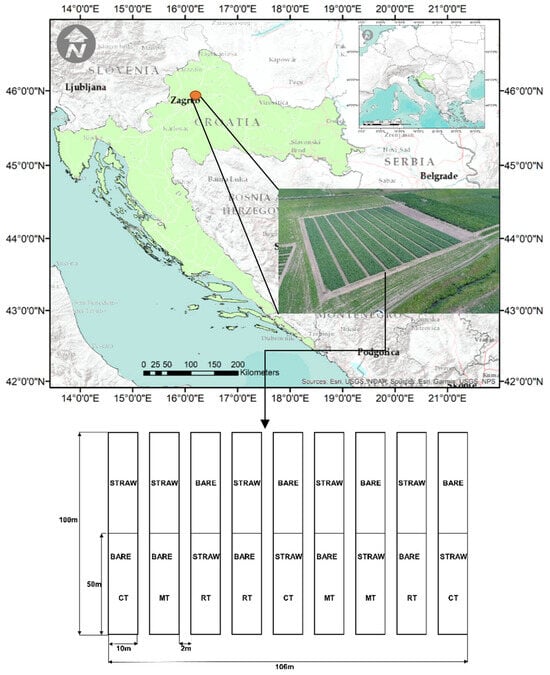
Figure 1.
Study location and experimental design.

Figure 2.
Monthly precipitation and temperature throughout the experimental period (2019–2021).

Table 1.
Soil properties at 0–30 cm depth.
2.2. Experimental Design and Management Practices
This study was carried out between 2019 and 2021 using a randomized split-plot block design with three replications (Figure 1). The main treatment involved tillage, while straw mulch application served as the sub-treatment. Each plot measured 100 m by 10 m (1000 m2), with tillage management as the primary factor. Within each plot, mulch application (with or without straw) was assigned to subplots of 50 m by 10 m (500 m2). Conventional tillage (CT) involves mouldboard ploughing in autumn, followed by disking and harrowing in early spring. Minimum tillage (MT) utilizes a multitiller in spring, whereas reduced tillage (RT) combines subsoiling in autumn with multitiller use in spring. Seedbed preparation was carried out uniformly across all plots. Further details on agricultural practices, machinery, and tools used for these interventions are provided in Table 2. Wheat straw (2.75 t/ha) was chopped to 5–10 cm in length and applied manually after sowing covering 100% of topsoil. Crop rotation applied in this experiment is common for Pannonian Croatia and consists of soybean (2019)–maize (2020)–spring wheat (2021) rotation. Soybean (AFZG Ana—maturation group 0) was sown on 25 April 2019 and harvested on 19 October 2019. Maize (Bc424—FAO 460, 75,000 seeds per hectare) was sown on 30 April 2020 and harvested on 3 October 2020. Spring wheat (Erwin) was sown on 20 March 2021 and harvested on 15 July 2021. Herbicides and pesticides were applied according to crop requirements and sanitary status, equally on all treatments. Fertilization differs according to crop requirements (soybean—400 kg/ha of NPK (7-20-30); maize—400 kg/ha of NPK (7-20-30) and 100 kg/ha of urea (46%); spring wheat—400 kg/ha of NPK (7-20-30) and 150 kg/ha of calcium ammonium nitrate (KAN) 27%). During the experiment, for all agricultural operations we used tractor John Deere 6930 (John Deere, Moline, IL, USA).

Table 2.
Summary of agricultural operations and used machinery.
Collection of undisturbed soil samples was carried out for each year of experiment in short period after sowing and after harvest. Undisturbed soil samples were collected using core samplers (100 cm3) at 0–10 cm and 10–20 cm depth. Overall, 108 undisturbed samples were collected per sampling date (18 treatments × 2 depths × 3 replicates) and average point was calculated per year. Furthermore, additional undisturbed samples (18 treatments × 3 replicates) were collected by shovel at 0–10 cm depth and were packed in plastic rectangular boxes for determining water-stable aggregate percentage and additionally disturbed samples (18 treatments × 3 replicates) from 0–20 cm depth were collected by soil probe to determine soil organic matter. For measuring soil penetration resistance, we used electric hand-pushed cone penetrometer (Penetrologger, Eijkelkamp, Giesbeek, The Netherlands) using a cone with a 1 cm2 base area, a 60° point angle, and an 80 cm driving shaft. For each sampling event across all plots, a total of 78 measurements (18 treatments × 4 replicates) were taken at a depth of 0–20 cm, with each point representing the average of four measurements.
Crop yields were determined by conducting three harvester passes per treatment, totalling 54 passes. The harvested seeds were cleaned and weighed, and the final yield values were adjusted to a standard grain moisture of 14%
2.3. Laboratory Analysis
Soil BD and WHC were measured by weighing the samples both before and after they underwent capillary wetting and then drying at 105 °C for 48 h. These measurements were subsequently used to calculate the values using the gravimetric method [26]:
Undisturbed soil samples were carefully hand-prepared following the method described by Dıaz-Zorita et al. [27] to prevent the breakdown of existing aggregates. The samples were then air-dried at room temperature (25 °C) for seven days, sieved, and weighed. Aggregates ranging from 1 to 2 mm were selected to assess aggregate stability using Eijkelkamp’s wet sieving apparatus and the procedure outlined by Kemper and Rosenau [28]. The percentage of water-stable aggregates (WSA) was calculated using the following formula:
In this context, WSA represents the percentage of water-stable aggregates, Wds is the weight of aggregates dispersed in a dispersing solution (g), and Wdw is the weight of aggregates dispersed in distilled water (g). SOM was measured using the wet digestion method [29] after the soil samples were air-dried, milled, and sieved through a 2 mm mesh.
2.4. Statistical Analysis
Two-way ANOVA design was carried out to identify differences in the BD, PR, WHC, WSA, SOM and crop yield (factors: tillage and straw cover). When ANOVA showed significant differences at p < 0.05, a Fisher’s LSD post hoc test was applied. Statistical analyses were computed with the Statistica (Version 14.3) software package [30], while the graphs were created using Excel.
3. Results
3.1. Bulk Density and Penetration Resistance
The bulk densities measured in 2019 and 2020 show significant impact (p < 0.05) in the interaction between tillage and cover, while there is no significant impact in 2021. In the mulched and bare plots, significantly lower values were measured in RT than in the MT and CT (Figure 3a). In 2020 (Figure 3b), on mulched plots, significantly lower values were observed in the RT compared to treatments MT and CT. On bare plots, there were no significant differences, with the values as follows: MT > CT > RT. Comparing the effect of mulch, the difference is not significant. In 2021 (Figure 3c), tillage and mulch had no significant effect on soil BD.
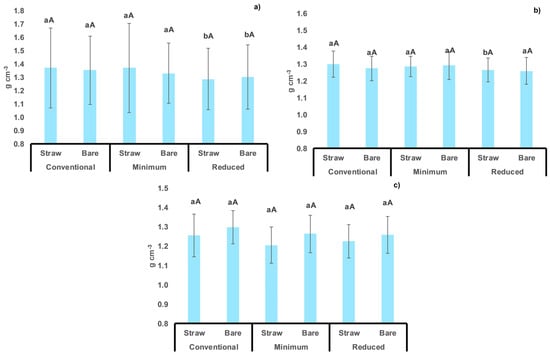
Figure 3.
Interaction factor effect of tillage and cover on soil bulk density in (a) 2019; (b) 2020; (c) 2021. Distinct letters indicate significant differences at p < 0.05, with lowercase letters denoting tillage treatments and uppercase letters representing cover treatments.
The interaction between tillage and soil cover has a significant effect on PR in 2019, 2020 and 2021 (p < 0.05). In 2019, a significant decrease in PR under straw was observed in CT and RT (Figure 4a). In 2020, the RT on mulched plots had a significantly lower PR than the CT and MT (Figure 4b). In 2021, a significant decrease in PR under straw was observed in all tillage treatments in addition to bare plots (Figure 4c).
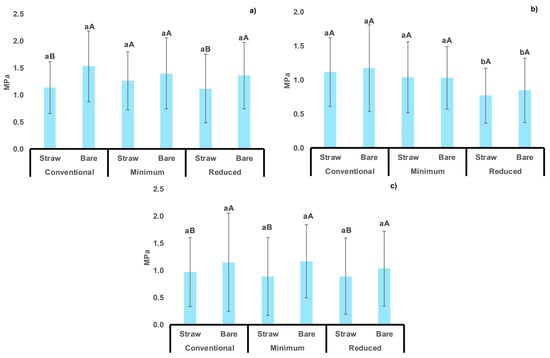
Figure 4.
Interaction factor effect of tillage and cover on soil penetration resistance in (a) 2019; (b) 2020; (c) 2021. Distinct letters indicate significant differences at p < 0.05, with lowercase letters denoting tillage treatments and uppercase letters representing cover treatments.
3.2. Water Holding Capacity
The interaction between tillage and soil cover shows a significant influence on WHC (p < 0.05) in 2019, 2020 and 2021. In 2019, straw mulch significantly increased WHC in MT plots compared to bare plots (Figure 5a). In the mulched plots, MT and RT had a significantly higher WHC than CT, while in the bare plots MT had a significantly lower WHC than CT and RT. In 2020, straw mulch elevated WHC in MT compared to bare plots (Figure 5b). In mulched plots, MT and RT had significantly higher WHC than CT, while there were no significant differences in bare plots. In 2021, a significant increase in WHC under straw was observed in the MT and RT treatments compared to bare plots (Figure 5c). In mulched plots, the MT treatment had a significantly higher WHC than CT and RT. In the bare plots, RT had a significantly lower WHC than CT and MT.
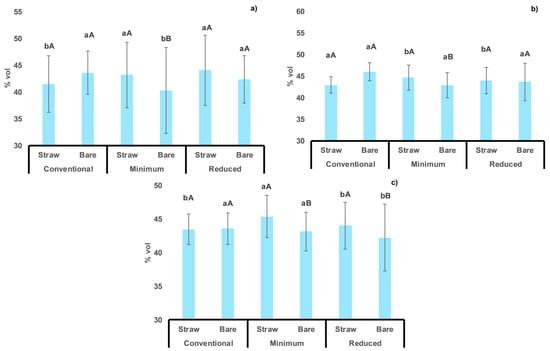
Figure 5.
Interaction factor effect of tillage and cover on water holding capacity in (a) 2019; (b) 2020; (c) 2021. Distinct letters indicate significant differences at p < 0.05, with lowercase letters denoting tillage treatments and uppercase letters representing cover treatments.
3.3. Water-Stable Aggregates
The interaction between tillage and soil cover shows significant effects on WSA in 2021, while the effects in 2019 and 2020 were not significant. In 2019, straw mulch relatively increased WSA in CT and RT (Figure 6a). Under mulch, the order of WSA was RT > MT > CT, while without mulch the order was MT > RT > CT. In 2020, straw mulch relatively increased WSA in CT, but decreased it in MT and RT (Figure 6b). In the mulched plots, the order of WSA was CT > MT > RT, and in the bare plots it was MT > RT > CT. In 2021, straw mulch significantly increased WSA in CT (Figure 6c). In both mulched and bare plots, MT had the highest WSA compared to CT and RT.

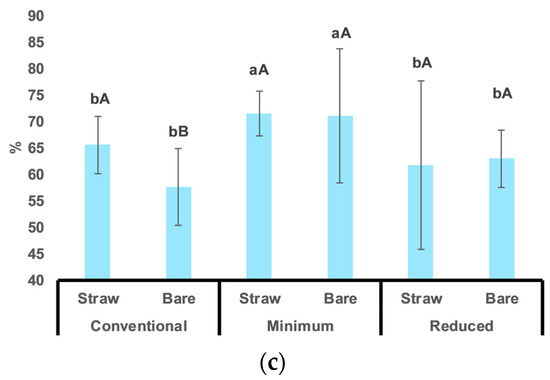
Figure 6.
Interaction factor effect of tillage and cover on water-stable aggregates in (a) 2019; (b) 2020; (c) 2021. Distinct letters indicate significant differences at p < 0.05, with lowercase letters denoting tillage treatments and uppercase letters representing cover treatments.
3.4. Soil Organic Matter
The interaction between tillage and soil cover shows no significant effect on SOM in 2019 and 2020 but is significant in 2021. In 2019 and 2020, straw insignificantly increased SOM in the CT treatment compared to the bare plots (Figure 7a,b). Under straw, the SOM values were in the order CT > RT > MT in 2019 and in the order MT > CT > RT in 2020, while in the bare plots the order was MT > RT > CT in both years. In 2021 (Figure 7c), straw mulch did not significantly increase SOM in MT and RT. In the mulched and bare plots, MT had a significantly higher SOM than CT.
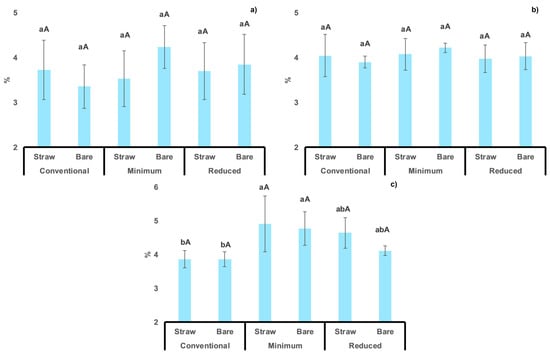
Figure 7.
Interaction factor effect of tillage and cover on soil organic matter in (a) 2019; (b) 2020; (c) 2021. Distinct letters indicate significant differences at p < 0.05, with lowercase letters denoting tillage treatments and uppercase letters representing cover treatments.
3.5. Yield
The interaction between tillage and soil cover showed no significant effect on soybean yield in 2019. The lowest yield was recorded in bare MT (3.43 t/ha) and the highest in mulched MT (4.30 t/ha). A comparison of the effect of straw mulch within each treatments shows a relative increase in soybean yields in the MT and RT treatments (Figure 8a). In the straw plots, soybean yields followed the order MT > RT > CT, while in the bare plots the order was CT > RT > MT. The interaction between tillage and soil cover had a significant effect on maize yield in 2020, with the lowest maize yield in MT with straw (8.68 t/ha) and the highest in RT without straw (13.95 t/ha). A comparison of the effects of mulch cover shows that straw reduces maize yield in all tillage treatments, while in MT there was a significant decrease under straw. In the straw plots, maize yields were significantly higher under RT than under MT. In the bare plots, yields followed the order RT > CT > MT. The interaction between tillage and soil cover had a significant effect on the yield of spring wheat in 2021. The yield was lowest under bare MT (1.75 t/ha) and highest under mulched MT (3.83 t/ha). Comparing the effects of mulching, the wheat yield in MT and RT (Figure 8c) increased significantly compared to the bare plots. In the mulched plots, RT and MT showed significantly higher wheat yields compared to CT. In the bare plots, the yields of RT were significantly higher than those of MT.
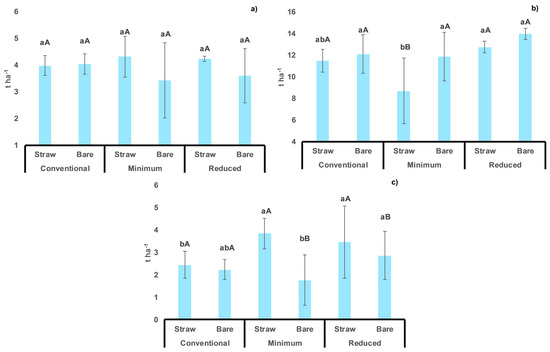
Figure 8.
Interaction factor effect of tillage and cover on yield in (a) 2019 (soybean); (b) 2020 (maize); (c) 2021 (wheat). Distinct letters indicate significant differences at p < 0.05, with lowercase letters denoting tillage treatments and uppercase letters representing cover treatments.
4. Discussion
It is highly recommended to investigate both BD and PR when observing changes in soil physical properties, especially soil compaction problems, as these values can be complementary to a better understanding and application of soil tillage management systems [15,31]. Throughout this study, all values of BD and PR were below levels that would diminish root development [32], but their modulations by different management practices are evident. Generally, on bare plots, BD values were significantly affected by vertical loosening in 2020 and produced lower compaction than ploughed and minimum-tilled soils. The same positive effect of loosening was found in other studies on clay soils in Ethiopia [33], silty loam soils in Croatia [34] or sandy loam soils in Belgium [35]. Interesting, during 2021 and 2022, loosening did not significantly reduce the soil BD in addition to CT and MT, although still recorded relatively lower BD values. Such a situation very likely occurs due to wet conditions during the tillage implementation in the last two years of research. It has already been reported that the beneficial effect of tools rapidly decreases if the condition of soil is unsatisfactory [4]. On the other hand, in mulched plots, studying tillage management suggests that vertical deep tillage with the application of straw mulch provides positive changes to loamy soil as is proved by significantly lower values at RT in addition to CT and MT. Straw application improves soil structure stabilisation and reduces aggregate breakdown [36], which is especially important in tillage management that does not turn over the soils like MT and RT and where organic residue decomposition is slower [37]. This effect is especially visible after more years of application on all tillage managements (Figure 3c and Figure 4c), indicating positive straw mulch effects on soil structure and soil resilience to re-compaction. Such a trend is especially evident when looking at PR results after 3 years of straw application (Figure 4c). All tillage treatments noted decreased PR on mulched plots, similar to Dekemati et al. [38]. As a consequence of air–water system modification, and due to the increasing depth of the loosened soil and the use of straw, land managers are enhancing water absorption and retention, which has become crucial in mitigating climate-related damage [39]. A high percentage of soil cover with straw mulch has proven beneficial for the ability of soil to retain and conserve soil water [38,40], like it is proven in our work through increased WHC. Such soil ability improves soil resilience to increasing climate variability and adaptation to extreme climate events [41]. In the first year of the experiment, WHC improvement is noted on mulched MT, but it seems that non-inversion tillage (MT and RT) with mulch has a more beneficial impact than mulched CT treatment. Similarly, the positive trend with soil non-inversion and straw mulch significantly continued in the second and third years of the experiment. This effect was achievable because of the increase in SOM throughout the experiment duration, as high SOM alters pore size distribution [41] through enhanced soil structure. This means that SOM is mostly responsible for the fate of aggregate stability, since they are strongly correlated [42,43]. Aggregate stability is a frequently studied property since it is responsible for plant growth and soil quality [44], but it changes when the soil system is slow. We found no significant differences between treatment in the first and second years of the experiment, as was also confirmed in other studies [45,46]. In the third year of the experiment, MT noted significantly higher WSA than other treatments, bare and mulched, indicating the need for low disturbance for preserving soil structure. The importance of mid-term application of non-inversion tillage with straw application to achieve a significant positive result was also recognized by Dekemati et al. [12] and Yuan et al. [9]. Minimum disturbance and mulching contributed to sustaining SOM in creating more stable aggregates [47] and increasing overall soil health [48]. Similar to changes of soil structure, the SOM concentrations also have gradual changes in addition to management type. Therefore, no significant differences for SOM between treatments in the first two years are expected. In the third year, significantly higher SOM values were recorded in the MT treatment compared to other treatments, which correlate with WSA temporal changes. Additionally, over the three-year period, although insignificant, a trend of relative increase in SOM was observed in the MT and RT treatments, while a decrease in SOM was noticeable under CT treatments. Similar SOM fluctuations were also recognized in the review studies [49,50]. After 2–3 years of applying reduced and/or conservation tillage management, a significant increase was noted in conservation treatments compared to conventional systems on Stagnosol [45], Luvisol [51] and Cambisol [9]. The SOM fate in conventional and conservation management systems is related to the speed of SOM mineralisation. Conservation management reduces the decomposition of organic matter and avoids pulverization of structural aggregates [52,53]. Lastly, all soil modifications in a three-year period affect grain yields. No significant differences between treatments were noted in the first year of the research, but a positive impact of straw application in reduced tillage systems was observed through a 21% increase (mulched MT) and a 15% increase (mulched RT) in soybean grain yields compared to plots without mulch. In the second year of the research, MT treatments achieved the lowest maize yields compared to other treatments, indicating the importance of deep drainage and enabling root system expansion for maize [34,54]. In the third research year, significantly higher wheat yields in mulched MT and mulched RT treatments compared to bare plots, while in CT treatments, there were no significant differences. Enhanced structure and higher SOM together with reduced trafficking events on conservation treatments increase wheat yield as proved in other studies [55,56,57].
The findings of this study align with those observed in other regions, highlighting the potential of conservation tillage and straw mulch across diverse agroecosystems. For instance, studies conducted in arid and semi-arid regions (e.g., [51,58]) have demonstrated improvements in soil structure, water retention, and crop yields under reduced tillage and mulching practices. Similarly, research from temperate regions, such as Afzalinia and Zabihi [59], corroborates the positive effects of these practices on reducing soil compaction and enhancing aggregate stability. However, unlike arid regions, where water conservation is the primary focus, the benefits observed in this study—conducted in a humid climate—emphasize improved SOM and enhanced resilience to compaction. These results support the applicability of conservation tillage systems in Central European agroecosystems, even under contrasting climatic conditions, and provide evidence that similar management practices can be adapted to other regions with appropriate modifications to local conditions.
While long-term studies are generally more conclusive for evaluating the cumulative effects of agricultural practices, our three-year experiment offers valuable insights into mid-term responses of Fluvisols under humid environments. Similar 3-year studies (e.g., [52,59]) have demonstrated that significant trends in soil physical and chemical properties can emerge within a few years, particularly when conservation practices are applied. In our study, key soil quality parameters such as WHC, SOM, and WSA showed measurable improvements by the third year, particularly under reduced tillage systems with straw mulch. These findings highlight the potential of such practices to enhance soil health even in the shorter term, providing immediate guidance for land managers seeking to improve sustainability. Although long-term observations would offer a more comprehensive understanding of these practices’ cumulative impacts, our results are consistent with previous mid-term studies that demonstrate early benefits of conservation tillage systems. This underscores the value of our research in contributing to actionable recommendations for sustainable soil management while also laying a foundation for future long-term studies to validate these findings over extended periods.
5. Conclusions
Conducted research enhanced the understanding of conservation management effects on Fluviosol and productivity in rotation soybean-maize-wheat under semihumid conditions. Given its favourable effects on soil productivity, the final year results suggest that non-inversion tillage, combined with straw mulch, could serve as a viable management strategy within the alternative farming systems of Central Europe. After 3 years of application, the mulched MT and RT generally improved the SOM and wheat grain yield compared to conventional tillage, while the MT improved the WHC and WSA compared to conventional tillage. Regardless, the tillage management straw significantly reduces the soil PR. Many case studies confirm the negative effect of long-term ploughing on soil and water properties. The present study confirms that mulching after 3 years of application significantly enhanced SOM on non-inversion tillage systems, which is linked to greater water retention and lower PR and greatly affects wheat grain yield. This also means that land managers could reduce the negative impact of ploughing by improving aggregate stability and reducing PR if they change their behaviour and use mulching as a regular practice. Therefore, the main conclusion is to use straw application in any tillage system to improve soil quality. Other implementation practices like the transition to non-inversion tillage only increase the probability to reduce the harmful effects associated with long-term use of conventional tillage and can serve as a promising method to prepare the soil’s resilience for future climate-changing weather extremes. These results have significant implications for regional agricultural practices and policies. The combination of reduced tillage and straw mulch demonstrates a sustainable approach to improving soil health and enhancing crop yields. These findings are particularly relevant for Central European agroecosystems, where the adoption of conservation practices is still limited. Furthermore, this research aligns with the European Union’s Common Agricultural Policy objectives, which aim to promote sustainable land management and mitigate soil degradation. By adopting these practices, land managers can improve soil resilience, reduce environmental impacts, and adapt to the challenges posed by climate variability. Policymakers should consider incentivizing these practices to accelerate their adoption and foster a transition toward sustainable agricultural systems in the region.
Author Contributions
Conceptualization, I.B.; Methodology, I.B.; Software, L.B. and I.B.; Validation, I.B.; Formal analysis, L.B.; Investigation, L.B.; Resources, I.B.; Data curation, L.B. and I.B.; Writing—original draft, L.B.; Writing—review & editing, L.B. and I.B.; Visualization, I.B.; Supervision, I.B.; Project administration, I.B. All authors have read and agreed to the published version of the manuscript.
Funding
This work was supported by the project “Monetary valuation of soil ecosystem services and creation of initiatives to invest in soil health: setting a framework for the inclusion of soil health in business and in the policy making process” (InBestSoil) (Horizon Europe, Grant agreement ID: 101091099).
Data Availability Statement
The raw data supporting the conclusions of this article will be made available by the authors on request.
Conflicts of Interest
The authors declare no conflicts of interest.
References
- Panagos, P.; Montanarella, L.; Barbero, M.; Schneegans, A.; Aguglia, L.; Jones, A. Soil priorities in the European Union. Geoderma 2022, 29, e00510. [Google Scholar] [CrossRef]
- Khan, N.; Ray, R.L.; Kassem, H.S.; Hussain, S.; Zhang, S.; Khayyam, M.; Ihtisham, M.; Asongu, S.A. Potential role of technology innovation in transformation of sustainable food systems: A review. Agriculture 2021, 11, 984. [Google Scholar] [CrossRef]
- Kassam, A.; Friedrich, T.; Derpsch, R. Global spread of conservation agriculture. Int. J. Environ. Stud. 2019, 76, 29–51. [Google Scholar] [CrossRef]
- Birkás, M.; Szemők, A.; Antos, G.; Neményi, M. Environmentally-Sound Adaptable Tillage; Akadémiai Kiadó: Budapest, Hungary, 2008; pp. 150–235. [Google Scholar]
- Arora, N.K. Impact of climate change on agriculture production and its sustainable solutions. Environ. Sustain. 2019, 2, 95–96. [Google Scholar] [CrossRef]
- Calistru, A.E.; Filipov, F.; Cara, I.G.; Cioboată, M.; Țopa, D.; Jităreanu, G. Tillage and Straw Management Practices Influences Soil Nutrient Distribution: A Case Study from North-Eastern Romania. Land 2024, 13, 625. [Google Scholar] [CrossRef]
- Jat, H.S.; Datta, A.; Choudhary, M.; Yadav, A.K.; Choudhary, V.; Sharma, P.C.; Gathala, M.K.; Jat, M.L.; McDonald, A. Effects of tillage, crop establishment and diversification on soil organic carbon, aggregation, aggregate associated carbon and productivity in cereal systems of semi-arid Northwest India. Soil Tillage Res. 2019, 190, 128–138. [Google Scholar] [CrossRef]
- Lv, L.; Zhoubing, G.; Kaihua, L.; Qing, Z.; Junjun, Z. Impact of conservation tillage on the distribution of soil nutrients with depth. Soil Tillage Res. 2023, 225, 105527. [Google Scholar] [CrossRef]
- Yuan, J.; Sadiq, M.; Rahim, N.; Tahir, M.M.; Liang, Y.; Zhuo, M.; Yan, L.; Shaheen, A.; Mahmood, B.; Li, G. Changes in soil properties and crop yield under sustainable conservation tillage Systems in Spring Wheat Agroecosystems. Land 2023, 12, 1253. [Google Scholar] [CrossRef]
- Derpsch, R. Conservation tillage, no-tillage and related technologies. In Conservation Agriculture: Environment, Farmers Experiences, Innovations, Socio-Economy, Policy; García-Torres, L., Benites, J., Martínez-Vilela, A., Holgado-Cabrera, A., Eds.; Springer: Dordrecht, The Netherlands, 2003; pp. 181–190. [Google Scholar] [CrossRef]
- Sadiq, M.; Rahim, N.; Tahir, M.M.; Alasmari, A.; Alqahtani, M.M.; Albogami, A.; Ghanem, K.Z.; Abdein, M.A.; Ali, M.; Mehmood, N.; et al. Conservation tillage: A way to improve yield and soil properties and decrease global warming potential in spring wheat agroecosystems. Front. Microbiol. 2024, 15, 1356426. [Google Scholar] [CrossRef]
- Dekemati, I.; Simon, B.; Bogunovic, I.; Vinogradov, S.; Modiba, M.M.; Gyuricza, C.; Birkás, M. Three-Year Investigation of Tillage Management on the Soil Physical Environment, Earthworm Populations and Crop Yields in Croatia. Agronomy 2021, 11, 825. [Google Scholar] [CrossRef]
- Haider, F.U.; Hussan, M.U.; Akhtar, K.; Liqun, C. Response of mulching and tillage practices on soil management. In Mulching in Agroecosystems: Plants, Soil & Environment; Akhtar, K., Arif, M., Riaz, M., Wang, H., Eds.; Springer Nature: Singapore, 2022; pp. 71–87. [Google Scholar] [CrossRef]
- Iqbal, R.; Raza, M.A.S.; Valipour, M.; Saleem, M.F.; Zaheer, M.S.; Ahmad, S.; Toleikiene, M.; Haider, I.; Aslam, M.U.; Nazar, M.A. Potential agricultural and environmental benefits of mulches—A review. Bull. Natl. Res. Cent. 2020, 44, 75. [Google Scholar] [CrossRef]
- Brezinščak, L.; Bogunović, I. Tillage and straw management impact on soil structure, compaction and soybean yield on fluvisol. J. Central Eur. Agric. 2021, 22, 133–145. [Google Scholar] [CrossRef]
- Schwilch, G.; Laouina, A.; Chaker, M.; Machouri, N.; Sfa, M.; Stroosnijder, L. Challenging conservation agriculture on marginal slopes in Sehoul, Morocco. Renew. Agr. Food Syst. 2015, 30, 233–251. [Google Scholar] [CrossRef]
- Qamar, R.; Ullah, E.; Saqib, M.; Javeed, H.M.R.; Rehman, A.; Ali, A. Influence of tillage and mulch on soil physical properties and wheat yield in rice-wheat system. West Afr. J. Appl. Ecol. 2015, 23, 21–38. [Google Scholar]
- Iqbal, M.; Anwar-ul-Hassan; Ibrahim, M. Effects of Tillage Systems and Mulch on Soil Physical Quality Parameters and Maize (Zea mays L.) Yield in Semi-Arid Pakistan. Biol. Agric. Hortic. 2008, 25, 311–325. [Google Scholar] [CrossRef]
- Sun, L.; Wang, S.; Zhang, Y.; Li, J.; Wang, X.; Wang, R.; Lyu, W.; Chen, N.; Wang, Q. Conservation agriculture based on crop rotation and tillage in the semi-arid Loess Plateau, China: Effects on crop yield and soil water use. Agric. Ecosyst. Environ. 2018, 251, 67–77. [Google Scholar] [CrossRef]
- Ramadhan, M.N. Yield and yield components of maize and soil physical properties as affected by tillage practices and organic mulching. Saudi J. Biol. Sci. 2021, 28, 7152–7159. [Google Scholar] [CrossRef]
- Cullum, R.F. Influence of tillage on maize yield in soil with shallow fragipan. Soil Tillage Res. 2012, 119, 1–6. [Google Scholar] [CrossRef]
- He, C.; Niu, J.R.; Xu, C.T.; Han, S.W.; Bai, W.; Song, Q.L.; Dang, Y.P.; Zhang, H.L. Effect of conservation tillage on crop yield and soil organic carbon in Northeast China: A meta-analysis. Soil Use Manag. 2022, 38, 1146–1161. [Google Scholar] [CrossRef]
- Xiao, L.; Kuhn, N.J.; Zhao, R.; Cao, L. Net effects of conservation agriculture principles on sustainable land use: A synthesis. Glob. Change Biol. 2021, 27, 6321–6330. [Google Scholar] [CrossRef]
- Kottek, M.; Grieser, J.; Beck, C.; Rudolf, B.; Rubel, F. World map of the Köppen-Geiger climate classification updated. Meteorol. Z. 2006, 15, 259–263. [Google Scholar] [CrossRef] [PubMed]
- IUSS Working Group WRB. World Reference Base for Soil Resources 2014, Update 2015. Available online: http://www.fao.org/3/i3794en/I3794en.pdf (accessed on 1 July 2024).
- Black, C.A. Methods of Soil Analysis. Part I; American Society of Agronomy: Madison, WI, USA, 1965; p. 1572. [Google Scholar]
- Díaz-Zorita, M.; Perfect, E.; Grove, J.H. Disruptive methods for assessing soil structure. Soil Tillage Res. 2002, 64, 3–22. [Google Scholar] [CrossRef]
- Kemper, W.D.; Rosenau, R.C. Aggregate stability and size distribution. In Methods of Soil Analysis, Part 1. Physical and Mineralogical Methods; Klute, A., Ed.; American Society of Agronomy: Madison, WI, USA, 1986; pp. 425–444. [Google Scholar]
- Walkley, A.J.; Black, I.A. Estimation of soil organic carbon by the chromic acid titration method. Soil Sci. 1934, 37, 29–38. [Google Scholar] [CrossRef]
- Statsoft. Statistica 14.3 Software; StatSoft Inc.: Hamburg, Germany, 2015. [Google Scholar]
- Silva, W.M.D.; Bianchini, A.; Cunha, C.A.D. Modeling and correction of soil penetration resistance for variations in soil moisture and soil bulk density. Eng. Agrícola 2016, 36, 449–459. [Google Scholar] [CrossRef]
- Hazelton, P.; Murphy, B. Interpreting Soil Test Results: What Do All the Numbers Mean? Csiro Publishing: Collingwood, Australia, 2007; pp. 5–31. [Google Scholar]
- Tebebu, T.Y.; Bayabil, H.K.; Steenhuis, T.S. Can degraded soils be improved by ripping through the hardpan and liming? A field experiment in the humid Ethiopian Highlands. Land Degrad. Dev. 2020, 31, 2047–2059. [Google Scholar] [CrossRef]
- Bogunovic, I.; Pereira, P.; Kisic, I.; Sajko, K.; Sraka, M. Tillage management impacts on soil compaction, erosion and crop yield in Stagnosols (Croatia). Catena 2018, 160, 376–384. [Google Scholar] [CrossRef]
- Vanderhasselt, A.; Steinwidder, L.; D’Hose, T.; Cornelis, W. Opening up the subsoil: Subsoiling and bio-subsoilers to remediate subsoil compaction in three fodder crop rotations on a sandy loam soil. Soil Tillage Res. 2024, 237, 105956. [Google Scholar] [CrossRef]
- Bogunović, I.; Filipović, V. Mulch as a nature-based solution to halt and reverse land degradation in agricultural areas. Curr. Opin. Environ. Sci. Health 2023, 34, 100488. [Google Scholar] [CrossRef]
- Mihretie, F.A.; Tsunekawa, A.; Haregeweyn, N.; Adgo, E.; Tsubo, M.; Ebabu, K.; Masunaga, T.; Kebede, B.; Meshesha, D.T.; Tsuji, W.; et al. Tillage and crop management impacts on soil loss and crop yields in northwestern Ethiopia. Int. Soil Water Conserv. Res. 2022, 10, 75–85. [Google Scholar] [CrossRef]
- Dekemati, I.; Simon, B.; Vinogradov, S.; Birkás, M. The effects of various tillage treatments on soil physical properties, earthworm abundance and crop yield in Hungary. Soil Tillage Res. 2019, 194, 104334. [Google Scholar] [CrossRef]
- Kovács, G.P.; Simon, B.; Balla, I.; Bozóki, B.; Dekemati, I.; Gyuricza, C.; Percze, A.; Birkás, M. Conservation tillage improves soil quality and crop yield in Hungary. Agronomy 2023, 13, 894. [Google Scholar] [CrossRef]
- Wang, S.; Guo, L.; Zhou, P.C.; Wang, X.; Shen, Y.; Han, H.; Ning, T.; Han, K. Effect of subsoiling depth on soil physical properties and summer maize (Zea mays L.) yield. Plant Soil Environ. 2019, 65, 131–137. [Google Scholar] [CrossRef]
- Abdallah, A.M.; Jat, H.S.; Choudhary, M.; Abdelaty, E.F.; Sharma, P.C.; Jat, M.L. Conservation Agriculture Effects on Soil Water Holding Capacity and Water-Saving Varied with Management Practices and Agroecological Conditions: A Review. Agronomy 2021, 11, 1681. [Google Scholar] [CrossRef]
- Fan, W.; Wu, J.; Ahmed, S.; Hu, J.; Chen, X.; Li, X.; Zhu, W.; Opoku-Kwanowaa, Y. Short-Term Effects of Different Straw Returning Methods on the Soil Physicochemical Properties and Quality Index in Dryland Farming in NE China. Sustainability 2020, 12, 2631. [Google Scholar] [CrossRef]
- Babur, E.; Kara, O.; Fathi, R.A.; Susam, Y.E.; Riaz, M.; Arif, M.; Akhtar, K. Wattle fencing improved soil aggregate stability, organic carbon stocks and biochemical quality by restoring highly eroded mountain region soil. J. Environ. Manag. 2021, 288, 112489. [Google Scholar] [CrossRef]
- Kumar, A.; Naresh, R.K.; Singh, S.; Mahajan, N.C.; Singh, O. Soil aggregation and organic carbon fractions and indices in conventional and conservation agriculture under vertisol soils of sub-tropical ecosystems: A review. Int. J. Curr. Microbiol. App. Sci. 2019, 8, 2236–2253. [Google Scholar] [CrossRef]
- Giannitsopoulos, M.L.; Burgess, P.J.; Rickson, J. Effects of conservation tillage drills on soil quality indicators in a wheat-oilseed rape rotation: Organic carbon, earthworms and water stable aggregates. Soil Use Manag. 2020, 36, 139–152. [Google Scholar] [CrossRef]
- Bartlová, J.; Badaliková, B.; Pospíšilová, L.; Pokorný, E.; Šarapatka, B. Water stability of soil aggregates in different systems of tillage. Soil Water Res. 2015, 10, 147–154. [Google Scholar] [CrossRef]
- Thai, S.; Davídek, T.; Pavlů, L. Causes clarification of the soil aggregates stability on mulched soil. Soil Water Res. 2022, 17, 91–99. [Google Scholar] [CrossRef]
- Six, J.; Bossuyt, H.; Degryze, S.; Denef, K. A history of research on the link between (micro)aggregates, soil biota, and soil organic matter dynamics. Soil Tillage Res. 2004, 79, 7–31. [Google Scholar] [CrossRef]
- Lemke, R.L.; VandenBygaart, A.J.; Campbell, C.A.; Lafond, G.P.; Grant, B. Crop residue removal and fertilizer N: Effects on soil organic carbon in a long-term crop rotation experiment on a Udic Boroll. Agric. Ecosyst. Environ. 2010, 135, 42–51. [Google Scholar] [CrossRef]
- Powlson, D.S.; Glendining, M.J.; Coleman, K.; Whitmore, A.P. Implications for soil properties of removing cereal straw: Results from long-term studies. Agron. J. 2011, 103, 279–287. [Google Scholar] [CrossRef]
- Mloza-Banda, M.L.; Cornelis, W.M.; Mloza-Banda, H.R.; Makwiza, C.N.; Verbist, K. Soil properties after change to conservation agriculture from ridge tillage in sandy clay loams of mid-altitude Central Malawi. Soil Use Manag. 2014, 30, 569–578. [Google Scholar] [CrossRef]
- Powlson, D.S.; Bhogal, A.; Chambers, B.J.; Coleman, K.; Macdonald, A.J.; Goulding, K.W.T.; Whitmore, A.P. The potential to increase soil carbon stocks through reduced tillage or organic material additions in England and Wales: A case study. Agric. Ecosyst. Environ. 2012, 146, 23–33. [Google Scholar] [CrossRef]
- Zhu, L.; Hu, N.; Yang, M.; Zhan, X.; Zhang, Z. Effects of Different Tillage and Straw Return on Soil Organic Carbon in a Rice-Wheat Rotation System. PLoS ONE 2014, 9, e88900. [Google Scholar] [CrossRef]
- Jug, I.; Brozović, B.; Ðurdević, B.; Wilczewski, E.; Vukadinović, V.; Stipešević, B.; Jug, D. Response of Crops to Conservation Tillage and Nitrogen Fertilization under Different Agroecological Conditions. Agronomy 2021, 11, 2156. [Google Scholar] [CrossRef]
- Achankeng, E.; Cornelis, W. Conservation tillage effects on European crop yields: A meta-analysis. Field Crop. Res. 2023, 298, 108967. [Google Scholar] [CrossRef]
- Madarász, B.; Juhos, K.; Ruszkiczay-Rüdiger, Z.; Benke, S.; Jakab, G.; Szalai, Z. Conservation tillage vs. conventional tillage: Long-term effects on yields in continental, sub-humid Central Europe, Hungary. Int. J. Agric. Sustain. 2016, 14, 408–427. [Google Scholar] [CrossRef]
- Carr, P.M.; Martin, G.B.; Gunderson, J.J. Impact of Tillage on Spring Wheat Yield. Available online: https://www.ndsu.edu/agriculture/sites/default/files/2022-10/Impact_of_Tillage_on_Spring_Wheat_Yield2007.pdf (accessed on 2 July 2024).
- Guan, D.; Al-Kaisi, M.M.; Zhang, Y.; Duan, L.; Tan, W.; Zhang, M.; Li, Z. Tillage practices affect biomass and grain yield through regulating root growth, root-bleeding sap and nutrients uptake in summer maize. Field Crop. Res. 2014, 157, 89–97. [Google Scholar] [CrossRef]
- Afzalinia, S.; Zabihi, J. Soil compaction variation during corn growing season under conservation tillage. Soil Tillage Res. 2014, 137, 1–6. [Google Scholar] [CrossRef]
Disclaimer/Publisher’s Note: The statements, opinions and data contained in all publications are solely those of the individual author(s) and contributor(s) and not of MDPI and/or the editor(s). MDPI and/or the editor(s) disclaim responsibility for any injury to people or property resulting from any ideas, methods, instructions or products referred to in the content. |
© 2025 by the authors. Licensee MDPI, Basel, Switzerland. This article is an open access article distributed under the terms and conditions of the Creative Commons Attribution (CC BY) license (https://creativecommons.org/licenses/by/4.0/).